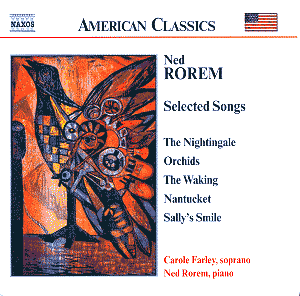 Composer: Ned Rorem
Composer: Ned Rorem
Works: Selected Songs – The Waking, Root Cellar, My Papa’s Waltz, I Strolled Across an Open Field, Memory, Orchids, The Serpent, Night Crow, Snake, Little Elegy, The Nightingale, Nantucket Lullaby of the Woman of the Mountain, Love in a Life, What If Some Little Pain, Visit to St. Elizabeth’s, Stopping by Woods on a Snowy Evening, Spring, See How They Love Me, Now Sleeps the Crimson Petal, I Am Rose, Ask Me No More, Far-Far-Away, Early in the Morning, Alleluia, Such Beauty as Hurts to Behold, Sally’s Smile, Youth, Day, Old Age and Night, O You Whom I Often and Silently Come, Full of Life Now, As Adam Early in the Morning, Are You the New Person?
Performers: Carole Farley (soprano), Ned Rorem (piano)
Recording: Old North Church, Nantucket, MA, June 2000
Label: NAXOS
Ned Rorem, a towering figure in American art song, has long been celebrated for his exquisite melding of lyrical melodies with deeply resonant texts. This recording, featuring the composer himself at the piano alongside soprano Carole Farley, presents a selection of his songs that encapsulate his musical ethos. Rorem, born in 1923, has composed a vast repertoire that exceeds 250 songs, often reflecting on themes of love, loss, and the ephemeral nature of existence. The works included here, with texts spanning American poets such as Theodore Roethke and Robert Frost, showcase Rorem’s ability to create music that is both intimate and expansive.
Farley’s interpretation is marked by a vibrant theatricality that breathes life into Rorem’s music. Her approach contrasts significantly with that of Susan Graham, who recently released a competing recording. While Graham’s interpretations lean toward the introspective and nuanced, Farley’s readings are more exuberant and direct. Take, for instance, her performance of “Orchids,” where she elongates her vowels and plays with the text’s rhythm, creating a more playful and immediate connection with the audience. This choice highlights Rorem’s melodic contours, allowing the music’s inherent joy to shine through. The plosive and heavily vowelled treatment of “Damp” in “What if Some Little Pain” exemplifies Farley’s penchant for dramatic expression, revealing a visceral engagement with the text that may be deemed excessive by some.
The technical execution of both performers is commendable, although the recording does present some limitations. Rorem’s pianism, while competent and expressive, lacks the expansive resonance found in more lavish productions. The sound quality, described as somewhat constricted, does not always do justice to the lush harmonies and intricate textures of Rorem’s piano writing. The NAXOS label, known for its “superbudget” offerings, perhaps sacrifices some acoustic richness in favor of accessibility. Despite this, there are moments where the piano and voice beautifully intertwine, particularly in “Stopping by Woods on a Snowy Evening,” where the subtle dynamics of Rorem’s accompaniment provide a poignant backdrop to Farley’s soaring lines.
Farley’s interpretation of Tennyson’s “Now Sleeps the Crimson Petal” starkly contrasts Graham’s more languid approach. Where Graham’s interpretation is characterized by a reflective quality, Farley opts for a brisk and vibrant rendition, clocking in significantly shorter while still capturing the song’s essence. Each choice reflects a different relationship to the text; Farley’s urgency and immediacy effectively mirror Rorem’s own directness in composition, underscoring the emotional weight of the words while sacrificing some of the atmospheric depth that Graham achieves.
The interplay of voice and piano in this recording offers a fascinating lens through which to explore Rorem’s oeuvre. Farley’s willingness to embrace extremes in vocal color can be both exhilarating and jarring, especially in songs like “The Serpent,” where her jazzy inflections and bold interpretations bring a fresh perspective. This album is an essential addition for those who appreciate the diversity of Rorem’s song repertoire and seek to understand the nuanced interpretations that arise from different performers.
Rorem’s Selected Songs, as presented by Farley and Rorem, serve as a compelling exploration of American art song. While the recording does not capture the full bloom of Rorem’s piano writing due to its sound engineering, it nonetheless invites listeners into the world of one of America’s most significant composers. Farley’s exuberant and at times controversial interpretive choices open new avenues for understanding Rorem’s music, making this recording a valuable resource for both casual listeners and dedicated enthusiasts alike. The contrast with other notable interpretations enriches the listening experience, prompting a re-evaluation of how Rorem’s songs can be expressed and understood.



